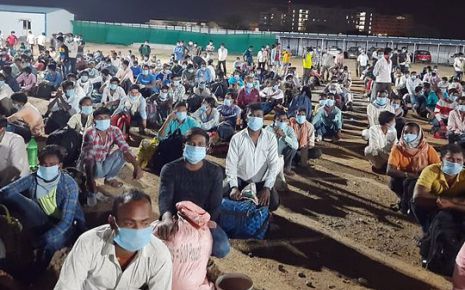Vishakha Case Revisited: An In-Depth Exploration of Its Legacy and Ongoing Implications in the Realm of Workplace Sexual Harassment Laws in India
"The Internet is becoming the town square for the global village of
tomorrow." - Bill Gates
The Internet and information technology are of highest importance in the world we live in today and have a significant impact on practically every aspect of our life. The Covid-19 pandemic's spread in 2019 and its ongoing impacts made the globe increasingly dependent on technology and the internet for people to continue to work, learn, and thrive. To continue leading the best lives they could, the populace started to rely increasingly heavily on technology.
"Information technology and the Internet are rapidly transforming almost every aspect of our lives – some for better, some for worse." – John Landgraf
The positive and the bad aspects of progress come along with this reliance on information technology and the internet. Change occurred in both positive and negative ways. People were able to organise better medical supplies, start relief funds, and ensure that work and education continued. With the aid of information technology and the internet, innovation became essential to survival. But along with goodness and the desire to improve comes the reverse, the desire to be evil and cause trouble. Hacking and online crime have increased.
"The Internet is a worldwide platform for sharing information. It is a community of common interests. No country is immune to such global challenges as cybercrime, hacking, and invasion of privacy." – Lu Wei
Cyberbullying and harassment pose a serious threat as a result of this quick transition to the online world. Because of the change to a "work from home" or "online" work culture, society is now more open to sexual harassment and abuse. Statistics show that compared to 2016 and 2017, there was a significant increase in the number of cybercrimes including sexual harassment in 2019. In comparison to 2018, the number of cybercrimes reported in 2019 was much greater. In 2019, there were 2,266 reports of cybercrimes involving sexual harassment or sexual exploitation.
To address this new threat that has emerged in the world of internet, the existing laws and regulations are both inadequate and out-of-date. Given the significant changes in our workplace culture and the potential that the world was forced into this work culture before it was ready, this issue of sexual harassment in cyberspace needs to be properly discussed. This topic needs to be understood and discussed in great detail with a sense of urgency because it is likely to be a persistent problem that won't go away anytime soon.
Introduction
Due in large part to the COVID predicament, the usage of the internet has greatly increased engagement in the digital world. Users have been exposed to becoming victims of sexual harassment while they use the site to acquire information. Due to its trait of anonymity, the biggest drawback of virtual sexual harassment is the difficulty in identifying the perpetrator. The victims of online sexual harassment frequently feel helpless and choose not to report it at all. Even if they do, their complaints have very little effect. Eight out of every 10 persons encounter some form of internet harassment.
The percentage of women who experience sexual harassment in the online world is about 41%. Abuse and insults, malicious rumours and gossip, defamatory remarks or threats on social media, trolling and attacks, or abuse from a coordinated group are the main types of harassment that have been reported. The Indian laws largely rely on amendments and existing provisions in the various legislation and fail to provide distinct provisions to fight such harassment.
According to the justification given, physical sexual harassment is the unwanted physical or nonverbal approaches in a sexual relationship, including touching.
The term "digital sexual harassment" refers to gender-based violence that is facilitated by technology and takes place in digital spaces like social media. There are many different ways in which women are sexually harassed online, according to the 2018 United Nations report by the Special Rapporteur on violence against women, its causes, and effects. The list covers doxing, image-based sexual harassment, networked harassment, and harassment. Online harassment may not include physical contact, but the perpetrator's actions have the same goal in both forms of harassment.Physical sexual harassment, as defined by the provided reason, is any unwanted physical or nonverbal approaches in a sexual relationship, including touching.
Gender-based violence that occurs in digital settings like social media and is made possible by technology is referred to as "digital sexual harassment." According to the 2018 United Nations report by the Special Rapporteur on violence against women, its causes, and effects, there are numerous ways in which women are sexually harassed online. Doxing, image-based sexual harassment, networked harassment, and harassment are all included on the list. Although physical contact may not be involved in online harassment, the perpetrator's activities are nonetheless intended to harass.
Was brutally gang-raped in 1992 as a result of her attempts to end the practise of child marriage that was then commonplace in support of the government's campaign against it. Five men attacked Bhanwari's spouse and violently raped her out of retaliation for Bhanwari.
Who they believed was responsible. Regarding sexual harassment at work, the Supreme Court of India issued the "Vishaka Guidelines" in the case of Vishaka and others v. State of Rajasthan in 1997. The court ordered that these rules be followed up until the problem is addressed via legislation.
The Sexual Harassment of Women at Workplace (Prevention, Prohibition and Redressal) Act, 2013, was passed by the Ministry of Women and Child Development some years after the Supreme Court's ruling in the case of Vishaka & vs. State of Rajasthan (1997). (POSH Act).In order to enhance and streamline the requirements under the POSH Act, the Ministry also created the Sexual Harassment of Women at Workplace (Prevention, Prohibition and Redressal) Rules, 2013 (POSH Rules), effective as of the same date.
Provisions of the POSH Act:
The POSH Act defines sexual harassment at work, establishes a process for handling complaints, and provides protections against unfounded or malicious accusations. Every company must establish an Internal Complaints Committee (ICC) at each office or branch with ten or more employees. The ICCs have civil court-like authority and must provide for conciliation before opening an inquiry, upon the complainant's request.
Publishing or transmitting online content that depicts children engaged in sexually explicit behaviour, etc. is punishable by up to three years in prison and a fine of two lakh rupees, per Section 67B of the IT Act. A person's privacy is infringed in situations where it is guaranteed that his undressing won't be recorded or at the very least expected that their private areas won't be viewed by the public. There are various ways through which this act can be committed, these are:
With these being discussed, it is also important to know how can a person protected from such disgusting crimes. Some of the ways are:
Conclusion
Sexual harassment online is one of the risks that has increased along with increased internet usage. Sexual harassment simply lacks physical contact or sensory perception when it occurs virtually; otherwise, it has the same psychological traumatising effect on the victim. Due to this, victims are less likely to speak out against the crimes and are more hostile toward strangers. The offenders now have an opportunity to flee without being caught.
The legal provisions could still use some work in order to include more comprehensive rights for everyone. A separate regulation is required to regulate ethical conduct on digital platforms as well. People are also perceived as being reluctant to report such crimes, which is primarily due to a lack of information about how to do so. If not prevented at the outset, this ignorance encourages the abuser to abuse his freedom of speech to conduct even terrible crimes.
The inquiry and suggested remedy are not adequate, but they are sufficient to launch a campaign for a comprehensive set of laws. As a result, one must pursue justice through numerous channels, with PIL being one of them. Consumers must be made aware of their legal options so they may defend themselves from these harassers and stay safe online.
People are also thought to be hesitant to report such crimes, which is mostly attributable to a lack of knowledge regarding how to do so. This ignorance encourages the abuser to exploit his freedom of speech to commit even harsher crimes if it is not stopped at the onset. Although the investigation and suggested remedy are insufficient, they are enough to start a campaign for a full set of laws. As a result, there are many avenues via which one might seek justice, with PIL being one among them. To defend themselves against these harassers and keep safe online, consumers must be made aware of their legal choices.
"The core cybercrime issue lies in the modus operandi and the cyber criminal's diligence. The police, judiciary and the investigating agencies need to keep abreast of the latest advances in web-based applications so that they can simply trace the actual doer. In India, cybercrimes against women are still taken lightly, mainly because the respect for women in our modern culture, in general, is declining, and a lot of people are also not able to come to grasp the fact that even sharing someone's picture online is a crime. In our general traditions, cybercrimes such as morphing and e-mail spoofing do not have moral support and are therefore taken lightly.
They must learn not to intervene with the personal lives of others, and it is also essential to enhance respect for women in the general public. Therefore, in order to tackle cybercrime against women in India, there is a need not only for stricter penal developments but also for a shift in the education system. Such reform does not come from within a single block of society, but individuals, administrations and various other bodies need to work together to bring such changes."
References:
Written By: Aabhas Soni and Nilesh Singh
The Internet and information technology are of highest importance in the world we live in today and have a significant impact on practically every aspect of our life. The Covid-19 pandemic's spread in 2019 and its ongoing impacts made the globe increasingly dependent on technology and the internet for people to continue to work, learn, and thrive. To continue leading the best lives they could, the populace started to rely increasingly heavily on technology.
"Information technology and the Internet are rapidly transforming almost every aspect of our lives – some for better, some for worse." – John Landgraf
The positive and the bad aspects of progress come along with this reliance on information technology and the internet. Change occurred in both positive and negative ways. People were able to organise better medical supplies, start relief funds, and ensure that work and education continued. With the aid of information technology and the internet, innovation became essential to survival. But along with goodness and the desire to improve comes the reverse, the desire to be evil and cause trouble. Hacking and online crime have increased.
"The Internet is a worldwide platform for sharing information. It is a community of common interests. No country is immune to such global challenges as cybercrime, hacking, and invasion of privacy." – Lu Wei
Cyberbullying and harassment pose a serious threat as a result of this quick transition to the online world. Because of the change to a "work from home" or "online" work culture, society is now more open to sexual harassment and abuse. Statistics show that compared to 2016 and 2017, there was a significant increase in the number of cybercrimes including sexual harassment in 2019. In comparison to 2018, the number of cybercrimes reported in 2019 was much greater. In 2019, there were 2,266 reports of cybercrimes involving sexual harassment or sexual exploitation.
To address this new threat that has emerged in the world of internet, the existing laws and regulations are both inadequate and out-of-date. Given the significant changes in our workplace culture and the potential that the world was forced into this work culture before it was ready, this issue of sexual harassment in cyberspace needs to be properly discussed. This topic needs to be understood and discussed in great detail with a sense of urgency because it is likely to be a persistent problem that won't go away anytime soon.
Introduction
Due in large part to the COVID predicament, the usage of the internet has greatly increased engagement in the digital world. Users have been exposed to becoming victims of sexual harassment while they use the site to acquire information. Due to its trait of anonymity, the biggest drawback of virtual sexual harassment is the difficulty in identifying the perpetrator. The victims of online sexual harassment frequently feel helpless and choose not to report it at all. Even if they do, their complaints have very little effect. Eight out of every 10 persons encounter some form of internet harassment.
The percentage of women who experience sexual harassment in the online world is about 41%. Abuse and insults, malicious rumours and gossip, defamatory remarks or threats on social media, trolling and attacks, or abuse from a coordinated group are the main types of harassment that have been reported. The Indian laws largely rely on amendments and existing provisions in the various legislation and fail to provide distinct provisions to fight such harassment.
Physical And Mental Harassment
In the Vishakha ruling, the courts defined sexual harassment. This case provided definitions for the terms "sexual harassment at work" and "Vishakha principles and norms for the same." The definition was broad and included objectionable sexually motivated behaviour, either explicitly or implicitly, as:- Physical contact and advances;
- A demand or request for sexual favours;
- Sexually coloured remarks;
- Showing pornography;
- Any other unwelcome physical or non-verbal conduct of a sexual nature.
According to the justification given, physical sexual harassment is the unwanted physical or nonverbal approaches in a sexual relationship, including touching.
The term "digital sexual harassment" refers to gender-based violence that is facilitated by technology and takes place in digital spaces like social media. There are many different ways in which women are sexually harassed online, according to the 2018 United Nations report by the Special Rapporteur on violence against women, its causes, and effects. The list covers doxing, image-based sexual harassment, networked harassment, and harassment. Online harassment may not include physical contact, but the perpetrator's actions have the same goal in both forms of harassment.Physical sexual harassment, as defined by the provided reason, is any unwanted physical or nonverbal approaches in a sexual relationship, including touching.
Gender-based violence that occurs in digital settings like social media and is made possible by technology is referred to as "digital sexual harassment." According to the 2018 United Nations report by the Special Rapporteur on violence against women, its causes, and effects, there are numerous ways in which women are sexually harassed online. Doxing, image-based sexual harassment, networked harassment, and harassment are all included on the list. Although physical contact may not be involved in online harassment, the perpetrator's activities are nonetheless intended to harass.
Vishaka V. State Of Rajasthan, Before The Posh Act (1997)
In the historical case of Vishaka Judgment, a woman was accused of sexual harassment at work. According to a ruling by the Supreme Court, sexual harassment includes unwanted or uninvited sexual favours or gestures from one gender toward the other. Bhanwari Devi, who worked for the Rajasthani government's rural development programme.Was brutally gang-raped in 1992 as a result of her attempts to end the practise of child marriage that was then commonplace in support of the government's campaign against it. Five men attacked Bhanwari's spouse and violently raped her out of retaliation for Bhanwari.
Who they believed was responsible. Regarding sexual harassment at work, the Supreme Court of India issued the "Vishaka Guidelines" in the case of Vishaka and others v. State of Rajasthan in 1997. The court ordered that these rules be followed up until the problem is addressed via legislation.
The Sexual Harassment of Women at Workplace (Prevention, Prohibition and Redressal) Act, 2013, was passed by the Ministry of Women and Child Development some years after the Supreme Court's ruling in the case of Vishaka & vs. State of Rajasthan (1997). (POSH Act).In order to enhance and streamline the requirements under the POSH Act, the Ministry also created the Sexual Harassment of Women at Workplace (Prevention, Prohibition and Redressal) Rules, 2013 (POSH Rules), effective as of the same date.
Provisions of the POSH Act:
The POSH Act defines sexual harassment at work, establishes a process for handling complaints, and provides protections against unfounded or malicious accusations. Every company must establish an Internal Complaints Committee (ICC) at each office or branch with ten or more employees. The ICCs have civil court-like authority and must provide for conciliation before opening an inquiry, upon the complainant's request.
- Penalties have been established for employers who violate the Act's requirements.
- In order to provide women working in the unorganised sector or small businesses with a sexual harassment-free workplace, the State Government will inform the District Officer in each district to form a Local Complaints Committee (LCC).
Voyeurism
Voyeurism is punishable under Section 66E of the IT Act when it violates someone's privacy. The act of taking pictures of someone's intimate parts without their permission, sending such photos to someone else, or publishing them is deemed a violation of that person's privacy and is punishable by up to three years in prison and a fine of up to two lakh rupees. Online publication or transmission of sexually explicit material is punishable by up to five years in prison and a fine of 10 lakh rupees under Section 67A of the IT Act. Repeated or consecutive convictions for such offences are punishable by up to 7 years in prison and a fine that might reach ten lakh rupees.Publishing or transmitting online content that depicts children engaged in sexually explicit behaviour, etc. is punishable by up to three years in prison and a fine of two lakh rupees, per Section 67B of the IT Act. A person's privacy is infringed in situations where it is guaranteed that his undressing won't be recorded or at the very least expected that their private areas won't be viewed by the public. There are various ways through which this act can be committed, these are:
- Digital Voyeurism: With the proliferation of smartphones and digital devices, voyeurism has evolved into a more technologically advanced form. Perpetrators can use hidden cameras, spyware apps, or hacking techniques to invade someone's privacy remotely. Preventing digital voyeurism requires cybersecurity measures, regular device and app security updates, and being cautious with sharing personal content online.
- Voyeurism and Technology: Advances in technology have made it easier for voyeurs to exploit individuals, especially through the use of "upskirting" or "downblousing" techniques. These involve taking unauthorized images or videos under someone's clothing, often without their knowledge. Legislation is being updated in many jurisdictions to address these specific forms of voyeurism.
- Consent and Revenge Porn: Sometimes, voyeuristic images or videos are distributed without the victim's consent, leading to revenge porn. This is a form of sexual harassment and can have devastating emotional and psychological consequences for the victim. Prevention involves educating people about the importance of consent and the legal consequences of sharing intimate content without permission.
- Online Voyeurism: Live streaming and video-sharing platforms have created new opportunities for voyeurism. Perpetrators may encourage individuals to engage in explicit activities while broadcasting them to a wider audience without their knowledge or consent. Ensuring the platforms have robust reporting mechanisms and content moderation is essential to prevent this.
With these being discussed, it is also important to know how can a person protected from such disgusting crimes. Some of the ways are:
- Consent Education: One way to prevent voyeurism is through comprehensive sex education programs that emphasize the importance of consent, boundaries, and respect for others' privacy from a young age. Teaching individuals about personal boundaries and consent can help deter voyeuristic behaviour.
- Legal Measures: Legislation can play a crucial role in preventing voyeurism. Laws that criminalize voyeurism, digital intrusion, and revenge porn can act as strong deterrents. Penalties for these offenses should be appropriately severe to discourage potential offenders.
- Privacy Measures: Individuals can take steps to protect their privacy, such as being cautious about sharing personal information or images online, using strong passwords, and regularly checking their devices for spyware. They should also be aware of their surroundings to prevent physical voyeurism.
- Surveillance and Security: Employers, institutions, and public places can use security measures such as surveillance cameras, privacy curtains, and warning signs to deter voyeuristic behaviour in areas where people expect privacy, like restrooms, changing rooms, and hotel rooms.
- Community Awareness: Communities can come together to raise awareness about voyeurism and support victims. Neighbourhood watch programs and community policing efforts can help deter voyeuristic activities.
- Reporting Mechanisms: Encouraging victims and witnesses to report voyeuristic incidents is crucial for prevention. Establishing easy and anonymous reporting mechanisms can provide a sense of security and deter potential offenders.
Conclusion
Sexual harassment online is one of the risks that has increased along with increased internet usage. Sexual harassment simply lacks physical contact or sensory perception when it occurs virtually; otherwise, it has the same psychological traumatising effect on the victim. Due to this, victims are less likely to speak out against the crimes and are more hostile toward strangers. The offenders now have an opportunity to flee without being caught.
The legal provisions could still use some work in order to include more comprehensive rights for everyone. A separate regulation is required to regulate ethical conduct on digital platforms as well. People are also perceived as being reluctant to report such crimes, which is primarily due to a lack of information about how to do so. If not prevented at the outset, this ignorance encourages the abuser to abuse his freedom of speech to conduct even terrible crimes.
The inquiry and suggested remedy are not adequate, but they are sufficient to launch a campaign for a comprehensive set of laws. As a result, one must pursue justice through numerous channels, with PIL being one of them. Consumers must be made aware of their legal options so they may defend themselves from these harassers and stay safe online.
People are also thought to be hesitant to report such crimes, which is mostly attributable to a lack of knowledge regarding how to do so. This ignorance encourages the abuser to exploit his freedom of speech to commit even harsher crimes if it is not stopped at the onset. Although the investigation and suggested remedy are insufficient, they are enough to start a campaign for a full set of laws. As a result, there are many avenues via which one might seek justice, with PIL being one among them. To defend themselves against these harassers and keep safe online, consumers must be made aware of their legal choices.
"The core cybercrime issue lies in the modus operandi and the cyber criminal's diligence. The police, judiciary and the investigating agencies need to keep abreast of the latest advances in web-based applications so that they can simply trace the actual doer. In India, cybercrimes against women are still taken lightly, mainly because the respect for women in our modern culture, in general, is declining, and a lot of people are also not able to come to grasp the fact that even sharing someone's picture online is a crime. In our general traditions, cybercrimes such as morphing and e-mail spoofing do not have moral support and are therefore taken lightly.
They must learn not to intervene with the personal lives of others, and it is also essential to enhance respect for women in the general public. Therefore, in order to tackle cybercrime against women in India, there is a need not only for stricter penal developments but also for a shift in the education system. Such reform does not come from within a single block of society, but individuals, administrations and various other bodies need to work together to bring such changes."
References:
- https://www.legalserviceindia.com/legal/article-374-case-analysis-vishaka-and-others-v-s-state-of-rajasthan.html
- https://www.legalbites.in/vishaka-ors-v-state-of-rajasthan-1997/.
- https://ncwapps.nic.in/pdfReports/Sexual%20Harassment%20at%20Workplace%20(English).pdf.
- https://blogs.lse.ac.uk/vaw/landmark-cases/vishaka-v-state-of-rajasthan/.
- https://www.legallore.info/post/vishaka-ors-vs-the-state-of-rajasthan-ors.
- https://www.livemint.com/Politics/urJMXjCEdwOTls7oLJoZYM/Its-time-to-rethink-Vishaka-to-include-past-incidents.html.
- https://lawcirca.com/vishaka-guidelines-a-step-towards-safer-workplace/.
Written By: Aabhas Soni and Nilesh Singh
Law Article in India
Legal Question & Answers
Lawyers in India - Search By City
LawArticles
How To File For Mutual Divorce In Delhi

How To File For Mutual Divorce In Delhi Mutual Consent Divorce is the Simplest Way to Obtain a D...
Increased Age For Girls Marriage

It is hoped that the Prohibition of Child Marriage (Amendment) Bill, 2021, which intends to inc...
Facade of Social Media

One may very easily get absorbed in the lives of others as one scrolls through a Facebook news ...
Section 482 CrPc - Quashing Of FIR: Guid...

The Inherent power under Section 482 in The Code Of Criminal Procedure, 1973 (37th Chapter of t...
The Uniform Civil Code (UCC) in India: A...

The Uniform Civil Code (UCC) is a concept that proposes the unification of personal laws across...
Role Of Artificial Intelligence In Legal...

Artificial intelligence (AI) is revolutionizing various sectors of the economy, and the legal i...








Please Drop Your Comments